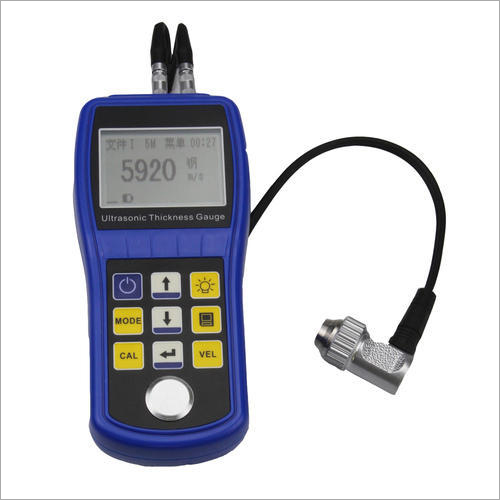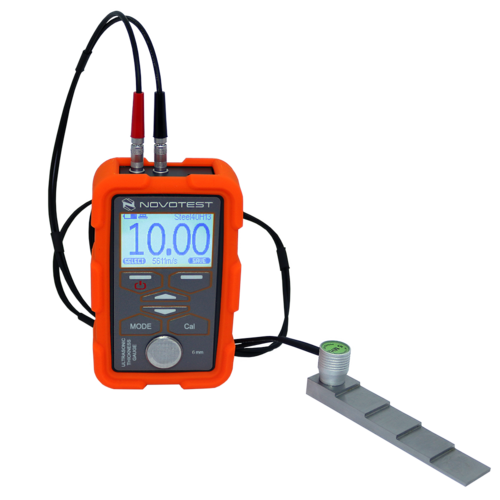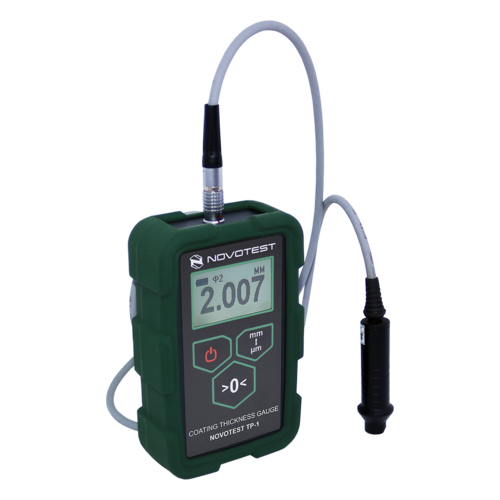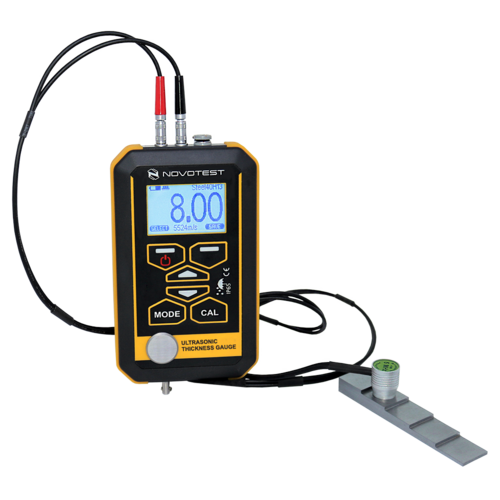Ultrasonic Digital Thickness Gauges
20000.00 INR/Piece
Product Details:
- Frequency 50-60 Hertz (HZ)
- Usage Industrial
- Size 155 x 68 x 27 mm
- Material Stainless Steel
- Product Type Ultrasonic Digital Thickness Gauges
- Color Blue
- Click to View more
X
Ultrasonic Digital Thickness Gauges Price And Quantity
- 20000.00 INR/Piece
- 1 Piece
Ultrasonic Digital Thickness Gauges Product Specifications
- Industrial
- 155 x 68 x 27 mm
- 50-60 Hertz (HZ)
- Stainless Steel
- Ultrasonic Digital Thickness Gauges
- Blue
Ultrasonic Digital Thickness Gauges Trade Information
- 100 Piece Per Week
- 7-10 Days
Product Description
Ultrasonic digital thickness gauges are instruments used for measuring the thickness of materials non-destructively. They utilize ultrasonic waves, typically in the frequency range of 0.5 MHz to 25 MHz, to penetrate the material being measured. The gauge sends out ultrasonic pulses through a transducer probe, which then reflects off the back wall or any internal interfaces within the material. By measuring the time it takes for the ultrasonic pulse to travel to the back wall and return, the gauge can calculate the thickness of the material.
Some key features and considerations for ultrasonic digital thickness gauges include:
1. Accuracy: Higher accuracy is desirable, especially for critical applications.
2. Range: The gauge should have a suitable range to measure the thickness of the intended materials.
3. Resolution: The resolution of the gauge determines the smallest increment it can measure. Higher resolution allows for more precise measurements.
4. Display: Clear and easy-to-read displays are important for user convenience.
5. Calibration: Periodic calibration is necessary to ensure accurate measurements.
6. Portability: Depending on the application, portability may be a factor. Some gauges are handheld for ease of use in various environments.
7. Data Logging: Advanced gauges may offer data logging capabilities, allowing users to store measurement data for analysis and documentation.
8. Material Compatibility: Ensure the gauge is compatible with the material being measured, as different materials have different acoustic properties.
Ultrasonic Digital Thickness Gauge Specifications:
1. Measurement Cycle: Single Point Measurement 6 Times/Per
2. Type: Gauge
3. Dimensions: 155 x 68 x 27 mm
4. Measuring Range: 0.75-225 mm
5. Material: Stainless Steel
6. Battery Type: Li-ion
7. Display: Digital
Ultrasonic Digital Thickness Gauges FAQ:
1. What is an ultrasonic digital thickness gauge?
Ans: An ultrasonic digital thickness gauge is a non-destructive testing instrument used to measure the thickness of materials using ultrasonic waves.
2. How does an ultrasonic thickness gauge work?
Ans: The gauge emits ultrasonic pulses through a transducer probe into the material being measured. The pulses reflect off the back wall or any internal interfaces within the material, and the gauge calculates the thickness based on the time it takes for the pulses to return.
3. What are the advantages of using ultrasonic thickness gauges?
Ans: Ultrasonic thickness gauges offer non-destructive testing capabilities, allowing for accurate measurements without damaging the material. They are also portable, versatile, and can be used on a wide range of materials.
4. What types of materials can ultrasonic thickness gauges measure?
Ans: Ultrasonic thickness gauges can measure the thickness of various materials including metals, plastics, glass, ceramics, composites, and more.
5. What is the typical accuracy of ultrasonic thickness gauges?
Ans: The accuracy of ultrasonic thickness gauges can vary depending on the model and application, but they typically offer high levels of accuracy, often within fractions of a millimeter.
6. How do I calibrate an ultrasonic thickness gauge?
Ans: Ultrasonic thickness gauges should be calibrated regularly according to the manufacturers instructions. Calibration involves setting the gauge to known standards of thickness to ensure accurate measurements.
7. Can ultrasonic thickness gauges measure through coatings or paint?
Ans: Yes, some ultrasonic thickness gauges are equipped with coating thickness measurement capabilities, allowing them to measure the thickness of coatings or paint layers on top of the material.
8. Are ultrasonic thickness gauges portable?
Ans: Yes, many ultrasonic thickness gauges are handheld and portable, making them suitable for use in various environments and applications.
9. Can ultrasonic thickness gauges store measurement data?
Ans: Some ultrasonic thickness gauges feature data logging capabilities, allowing users to store measurement data for later analysis and documentation.
10. What industries use ultrasonic thickness gauges?
Ans: Ultrasonic thickness gauges find applications in industries such as manufacturing, aerospace, automotive, construction, marine, oil and gas, and more, where accurate measurement of material thickness is essential for quality control and safety.
Precision Measurement for Industrial Needs
This ultrasonic thickness gauge is tailored for rigorous industrial environments, delivering reliable readings even on challenging surfaces. Its advanced ultrasonic technology ensures consistent accuracy across various material types, making it a vital asset for quality assurance and maintenance teams.
Reliable and Durable Construction
Built with stainless steel, the device offers robustness and resistance to corrosion. Its blue finish enhances visibility in busy industrial settings, while the compact size ensures easy integration into routine inspection workflows without sacrificing durability or portability.
FAQs of Ultrasonic Digital Thickness Gauges:
Q: How does the Ultrasonic Digital Thickness Gauge work?
A: It uses ultrasonic pulse-echo technology to measure the thickness of various materials, including metals. By sending ultrasonic waves through the material and detecting the echo, it calculates the precise thickness without requiring direct access to both sides.Q: What materials can this thickness gauge measure accurately?
A: While the device is made of stainless steel, it is designed to measure a wide range of materials such as metals, plastics, ceramics, and composites, making it suitable for diverse industrial tasks.Q: When should I use the ultrasonic thickness gauge in industrial applications?
A: You should use this device during routine maintenance checks, production quality assurance, or when you need to assess the integrity and wear of materials without causing any damage.Q: Where can I find support or after-sales service for this product in India?
A: As a manufacturer, exporter, supplier, trader, and service provider based in India, we offer comprehensive support and after-sales services across the country to ensure seamless operation and maintenance.Q: What is the process for using the Ultrasonic Digital Thickness Gauge?
A: Simply apply the coupling gel to the materials surface, place the probe firmly against the area, and the digital display will quickly show the accurate thickness measurement in real time.Q: What are the notable benefits of using this thickness gauge?
A: Key benefits include non-destructive measurement, precise and rapid results, and the ability to measure materials in hard-to-reach or single-sided applications, thereby enhancing efficiency and safety.Tell us about your requirement

Price:
Quantity
Select Unit
- 50
- 100
- 200
- 250
- 500
- 1000+
Additional detail
Mobile number
Email
 English
English Spanish
Spanish French
French German
German Italian
Italian Chinese (Simplified)
Chinese (Simplified) Japanese
Japanese Korean
Korean Arabic
Arabic Portuguese
Portuguese






 Call Me Free
Call Me Free
